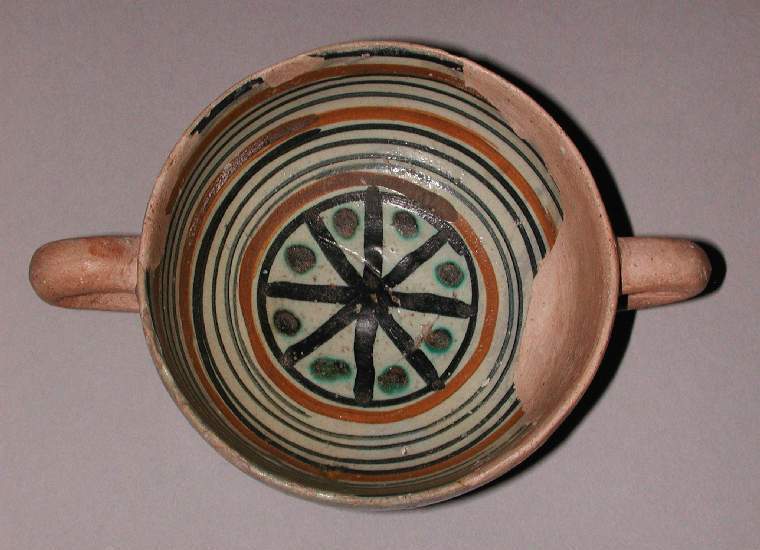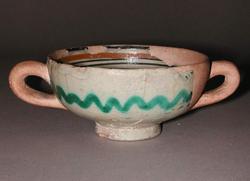Current Location: In storage
Maker(s)
Maker:
Unknown
(Probably)
Entities
Categories
Description
Renaissance maiolica two-handled bowl, painted in orange, green and black with a black wheel in the middle surrounded by concentric circles.
Earthenware, thrown with applied handles, tin-glazed greyish-cream on both sides; base unglazed. Painted in orange, a little dark green, and black.
Shape 45, but shallower. Circular with curved sides and two loop handles, standing on a narrow foot.
In the middle is a black wheel with green spots between the spokes; on the sides, concentric bands: orange, four black, orange, three black, orange and black. Outside, there is a wavy green line.
Notes
History note: Purportedly excavated in Orvieto. Purchased from Kerin, London, on 9 December 1933 by H.S. Reitlinger (d.1950); the Reitlinger Trust, Maidenhead, from which transferred in 1991.
Legal notes
H.S. Reitlinger Bequest, 1950.
Measurements and weight
Diameter: 4.3 cm
Height: 5 cm
Width: 14.8 cm
Acquisition and important dates
Method of acquisition: Bequeathed
(1950)
by
Reitlinger, Henry Scipio
Dating
15th Century
16th Century, Early
Renaissance
Circa
1450
CE
-
1510
CE
Note
During the second half of the 15th century simply decorated two-handled bowls were made in immense quantities in central Italy, judging by the numbers extant. They are usually decorated in two or three colours with a central medallion containing a stylized plant motif, grid or spots, surrounded by concentric circles, and may have horizontal bands or fan-like palmettes or half-palmettes on the exterior. Large quantities of them have been recovered from butti (rubbish pits) in Orvieto. Similar motifs occur on a bowl and on the front of a jug found at a kiln site adjacent to the Pozzo della Cava, Orvieto.
School or Style
Renaissance
Components of the work
Decoration
composed of
high-temperature colours
( orange, dark green, and black)
Bowl
Materials used in production
base unglazed
Tin-glaze
Earthenware
Techniques used in production
Tin-glazing
References and bibliographic entries
Identification numbers
Accession number: C.150-1991
Primary reference Number: 72105
Packing number: EURCER 946
Stable URI
Audit data
Created: Saturday 6 August 2011
Updated: Tuesday 30 April 2024
Last processed: Wednesday 14 May 2025
Associated departments & institutions
Owner or interested party:
The Fitzwilliam Museum
Associated department:
Applied Arts





